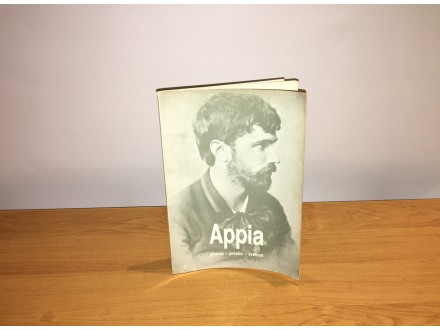ADOLF APIJA - 1862-1928 - glumac-prostor-svetlost
| Cena: |
| Stanje: | Polovan bez oštećenja |
| Garancija: | Ne |
| Isporuka: | AKS BEX City Express Pošta DExpress Post Express Lično preuzimanje |
| Plaćanje: | Tekući račun (pre slanja)
PostNet (pre slanja) Ostalo (pre slanja) Lično |
| Grad: |
Beograd-Stari grad, Beograd-Stari grad |
ISBN: Ostalo
Godina izdanja: 1989
Autor: Domaći
Oblast: Pozorište
Jezik: Srpski
ADOLF APIJA - 1862-1928 - glumac-prostor-svetlost
Katalog priredio - Radoslav Lazić
Izdavač - R. Lazić i M. Arnaut, Beograd
Godina - 1989
63 strana
24 cm
Povez - Broširan
Stanje - Kao na slici, ima potpis Dušana Stojanovića, tekst bez podvlačenja
SADRŽAJ:
RADOSLAV LAZIĆ - Uvod
Iz dela Apije
Apija u očima drugih
DENI BABLE - Apija i pozorišni prostor
MARI-LUIZ BABLE-HAN - Adolf Apija - `Inovator` modernog pozorišta
Svedočanstva o Apiji
Apija u jugoslovenskoj teatrologiji
Tekstovi i legende
Aneks
`Adolphe Appia (1 September 1862 – 29 February 1928), son of Red Cross co-founder Louis Appia, was a Swiss architect and theorist of stage lighting and décor.
Appia is best known for his many scenic designs for Wagner’s operas. He rejected painted two-dimensional sets for three-dimensional `living` sets because he believed that shade was as necessary as light to form a connection between the actor and the setting of the performance in time and space. Through the use of control of light intensity, colour and manipulation, Appia created a new perspective of scene design and stage lighting.
Directors and designers have both taken great inspiration from the work of Adolphe Appia, whose design theories and conceptualizations of Wagner’s operas have helped to shape modern perceptions of the relationship between the performance space and lighting. One of the reasons for the influence of Appia’s work and theories, is that he was working at time when electrical lighting was just evolving. Another is that he was a man of great vision who was able to conceptualize and philosophize about many of his practices and theories.
The central principle underpinning much of Appia’s work is that artistic unity is the primary function of the director and the designer. Appia maintained that two dimensional set painting and the performance dynamics it created, was the major cause of production disunity in his time. He advocated three elements as fundamental to creating a unified and effective mise en scene:
Dynamic and three dimensional movements by actors
Perpendicular scenery
Using depth and the horizontal dynamics of the performance space
Appia saw light, space and the human body as malleable commodities which should be integrated to create a unified mise en scene. He advocated synchronicity of sound, light and movement in his productions of Wagner’s operas and he tried to integrate corps of actors with the rhythms and moods of the music. Ultimately however, Appia considered light as the primary element which fused together all aspects of a production and he consistently attempted to unify musical and movement elements of the text and score to the more mystical and symbolic aspects of light. He often tried to have actors, singers and dancers start with a strong symbolic gesture or movement and end with another strong symbolic pose or gesture. In his productions, light was ever changing, manipulated from moment to moment, from action to action. Ultimately, Appia sought to unify stage movement and the use of space, stage rhythm and the mise en scene.
Appia was one of the first designers to understand the potential of stage lighting to do more than merely illuminate actors and painted scenery. His ideas about the staging of `word-tone drama`, together with his own stagings of Tristan und Isolde (Milan 1923) and parts of the Ring (Basle 1924-25) have influenced later stagings, especially those of the second half of the twentieth century.
For Appia and for his productions, the mise en scene and the totality or unity of the performance experience was primary and he believed that these elements drove movement and initiated action more than any thing else (Johnston 1972). Appia’s designs and theories went on to inspire many other theatre creators such as Edward Gordon Craig, Jacques Copeau and Wieland Wagner.`
Ako Vas nešto zanima, slobodno pošaljite poruku.
Adolphe Appia
1. Svakog dana, bilo kad, na mojoj adresi sa Limunda/Kupinda.
2. Svakog radnog dana posle 15h na Zelenom vencu ili Trgu republike.
Šaljem u inostranstvo, primam uplate preko servisao kao što su Pay Pal, RIA, Western Union (otvoren sam i za druge mogućnosti, javite se pre kupovine i dogovorićemo se).
Kao način slanja stavio sam samo Poštu i Postexpress jer sam s njima najviše sarađivao i vrlo sam zadovoljan, ali na Vaš zahtev mogu da šaljem i drugim službama.
Besplatna dostava na knjigama koje su obeležene tako se odnosi samo na slanje preporučenom tiskovinom.
Predmet: 70959681











